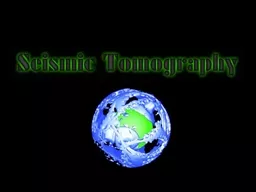

Seismic Waves are shock waves given off by earthquakes There are 2 types 1 Body Waves originate from the focus F travel through the earth Theyre used to locate ID: 675036
Download Presentation The PPT/PDF document "Seismic Waves Surface Waves" is the property of its rightful owner. Permission is granted to download and print the materials on this web site for personal, non-commercial use only, and to display it on your personal computer provided you do not modify the materials and that you retain all copyright notices contained in the materials. By downloading content from our website, you accept the terms of this agreement.
Slide1Slide2
Seismic Waves
Surface Waves
Seismic
Waves
are shock
waves
given off by earthquakes.
There are 2 types:
1. Body Waves originate from the focus (F)travel through the earth. They’re used to locate epicenters (E.)
E
FSlide3
2 Types of Body Waves
Surface Waves
Primary
(P) Waves
–
compression
waves
travel
fastest
through solids first waves to arriveSecondary (S) Waves shear wavescannot travel through liquidssecond to arriveonly half as fast as P waves
E
FSlide4
2 Types of Body Waves
P Waves
–
Compressional (or Longitudinal)
Waves
2) S Waves
– Shear WavesSlide5
Seismic Waves
Surface Waves
Seismic
Waves
are shock
waves
given off by earthquakes.
There are 2 types:
Surface Waves (also called L (Long) Waves) Start forming when body waves reach the surface at the epicenter,They arrive much later than body waves.
E
FSlide6
Seismology
Seismic Body Waves and the Earth’s InteriorSlide7
S Waves do not
travel through
liquids
.Slide8
S Waves do not
travel through the
outer
core.Slide9
The
outer core
must be
liquid
.Slide10
P waves slow down in the
outer
core and then
speed up in the
inner core.Slide11
Bending of P Waves Creates Two
S
mall “Shadow Zones”Slide12
P Wave Travel Paths
P Wave Direction
P Wave
Wave
FrontsSlide13
Conclusion:The inner core
must be
solid
.Slide14
Two Shadow Zones
Note:
S Waves
are totally blocked by the
outer core, so they have a
huge shadow zone.Slide15
Seismic Waves and Earth Layers
Seismic Waves travel
faster
through
cold, dense rock and slow down
traveling through warm, less dense
rock.Slide16
Seismic Waves and Earth Layers
There is a
sharp rise
in
wave speed
between the crust and mantle
and again between the mantle and the outer core. Slide17
Seismic Waves and Earth Layers
These sudden changes in wave speed are due to
sharp changes
in the
type
and density of rock which are called discontinuities. Slide18
Mohorovičić Discontinuity (Moho
)
Andrija
Mohorovičić
Sharp boundary between the
crust
and
upper mantleSlide19
When you get a
CT scan
(
Computerized Tomography Scan
), the machine records your body image in a series of “slices”…Slide20
Computerized Tomography
…which the computer puts together into a detailed
3-D image
of your body’s soft tissue and internal organs.Slide21
Seismic Tomography
Geophysicists use a similar technique with hundreds of seismic stations worldwide to make a
3 – D seismic tomographic image:Slide22
Layers of the Earth
Basic seismology told us that Earth has four main layers.Slide23
4 Earth Layers*
Seismic Tomography allows us to see smaller details in Earth’s structure that we didn’t know about before.Slide24
4 Earth Layers* - Plus One
There are 4 main layers…
*plus
another:
The
D” layer
is a thin layer in the lower 100 km of the lower mantle.
The Core/Mantle boundary is very
rugged and mountainous. Slide25
Anti-Continents and Anti-Oceans
Solid Mantle
Liquid Iron Outer Core
“Anti-Continents”
“Anti-Oceans”Slide26
2 More Boundary Layers (Discontinuities) below the
Moho
1)
2)
3)Slide27
Ultra-Low Velocity Zone (ULVZ)
A soft “squishy “ region found along the D” Core/Mantle Boundary is called the
U
ltra-
L
ow Velocity Zone (ULVZ
).(Seismic waves slow way down.)Slide28
Core-Mantle BoundarySlide29
D” Layer – Bottom 100 km of MantleSlide30
Mantle “Blobs”
Hot Blobs are less dense and rise towards the surface.
Cold Blobs are more dense and sink lower in the mantle.Slide31
Tomogram and Topographic Map - Mantle Blobs
Bring up QuickTimeSlide32
Tomograms of Mid and Deep Mantle
Red
– hot light rock
Blue – cold heavy rockSlide33
Tomograms of Mid and Deep Mantle
Red
– hot light rock
Blue – cold heavy rockSlide34
Mantle Blobs and Gravity Anomalies
Satellite bobs up
Satellite bobs downSlide35
Tomographic Map of Japan and ChinaSlide36
Cross-Section across Japan and China
Blue
- heavy
rock:
Sinking ocean crust
“flattens out” at 500 km and then eventually continues to
sink into the lower mantle.Slide37
Tomogram of Pacific Ocean Crust and Mantle
Brown
=
warm,
light rock Blue = cold, heavy rockSlide38
World Tomogram
Blue
blobs show
heavy sinking slabs of crust.Red
blobs show warm, rising blobs of rock.Slide39
“Convection Plumes”
Hot
, less dense plumes
rise
up, while
cold
, denser plumes sink in a circular motion called convection.Slide40
“Convection Plumes”
Hot
, less dense plumes
rise
up, while cold, denser plumes sink in a circular motion called
convection.Slide41Slide42
Surface Waves
Love
Waves -
Horizontal
shear
Rayleigh
Waves
–
Vertical shear
The combined effect of horizontal and vertical shear is to wrench buildings and highways apart.